|
Devendra Mulachari:
The brainchild behind Kandy's brilliant designs
by D. D. M. Waidyasekera
Relatively little has been written about one of the most brilliant
designers and royal artificers produced by the Kandyan Kingdom -
Devendra Mulachari. He designed and built some of the most historic
monuments in the Kandyan Kingdom, including the Pattirippuwa or Octagon
of the Sri Dalada Maligawa, the Cloud Wall or Walakulu Bemma surrounding
the Maligawa, the Diyarella Bemma or ornamental wall surrounding the
Kandy Lake and the Magul Maduwa or Audience Hall in Kandy.
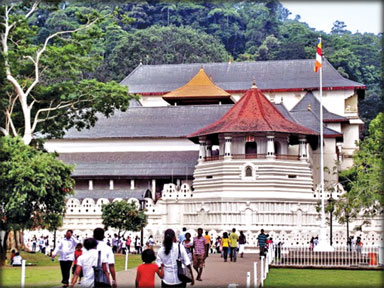 |
|
The Pattirippuwa of the Sri Dalada
Maligawa, one of the most outstanding designs of Devendra
Mulachari |
He lived and worked under three Kings, Kirthi Sri Rajasinha (AD
1747-1782), Rajadhi Rajasinha (1782-1798) and Sri Wickreme Rajasinha
(1798-1815).
Little is known of his origins. King Kirthi Sri Rajasinha (AD
1747-1782), on the advice of Ven. Weliwita Sangharaja Saranankara Thera,
is said to have rebuilt and renovated hundreds of Buddhist temples which
were destroyed by invaders or were abandoned.
For the restoration work, the King employed traditional Sinhala
artists who were scattered throughout the country. Some of them came
from Devundara (Dondra) in the South and one belief is that Devendra
Mulachari’s father was also in this group and settled down at
Madakumbura in Kotmale. Devendra Mulachari himself appears to have
settled in Arattana in Udunuwara circa AD 1750 during the reign of King
Kirti Sri Rajasinha.
His first architectural work was the Madama or Bana Maduwa at
Middeniya (Lawrie’s Gazetteer, p. 589). Middeniya is a village in
Udapalata Korale, Tumpane. It was a construction of about 500 sq. ft. on
a land about six perches in size. The original construction had a
four-sloped roof with ancient flat tiles (pethi ulu) and one door. The
original construction is not visible now.
Folklore
Another of Devendra Mulachari's constructions was the Pekada Kamhala
at Madakumbura, Kotmale. King Sri Wickreme Rajasinha entrusted him with
the task of constructing this building. According to folklore, settlers
there found that agricultural implements were not readily available for
cultivation nor were there facilities for repair and maintenance of
tools and implements. On their request the King sent Devendra Mulachari
to construct a workshop to manufacture, repair and maintain agricultural
implements. This was Pekada Kamhala, 32 feet in length and 15 feet in
breadth, about 500 sq. ft. in extent, standing on six stone pillars with
wooden carvings on top. Of the entire structure, only one stone pillar
is left along with the stone foundation which is visible.
Octagon
He was then entrusted with the construction of the Pattirippuwa or
Octagon of the Dalada Maligawa. Devendra Mulachari first constructed a
model of the proposed structure, using the stems of plantain trees, and
showed it to the King. On the King's approval of the model, work
commenced and the building was completed.
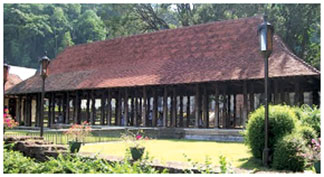 |
|
The Magul Maduwa or
Audience Hall in Kandy |
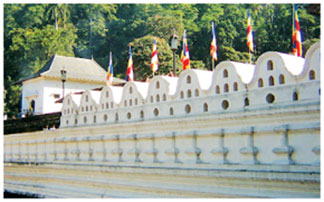 |
|
The Cloud Wall or Walakulu Bemma
around the Sri Dalada Maligawa |
It enabled the King to have a grand view of Kandy and enjoy martial
arts, dances and other cultural events with ease and relaxation.
However, an exception was when the Sacred Tooth Relic was taken in
procession at the annual Dalada Perahera when the King always got down
to a lower elevation to view the Perahera.
Devendra Mulachari is also credited with the planning and
construction of the moat running alongside the Maligawa and the Royal
Palace, and the highly original concept of the Cloud Wall or Walakulu
Bemma surrounding the Maligawa. However, the project was not completed
during the Mulachari’s lifetime.
Devendra Mulachari and his son are also credited with creating some
of the carvings at the Embekke Devala. Out of 514 carvings, 128 are
elaborate carvings in the pillars, their uniqueness being that all are
different from each other.
The title Mulachari, according to Dr. Vimalananda Tennakoon, was
given to an artificer who was well versed and an expert in at least five
arts and crafts. The royal artificers of the Kandyan Kingdom formed a
close corporation, divided into four workshops or pattales. They were
the Abharana Pattale (workshop for ornaments or jewellery), Otunu
Pattale (workshop for crowns), Ran-Kadu Pattale (workshop for golden
swords) and Sinhasana Pattale (workshop for thrones) – D’Oyly p. 135;
Knox p. 108.
Devendra Mulachari was the chief, not only of one workshop, but due
to his skill and brilliance, of all four workshops during his time.
With regard to his personal life, as far as can be gathered from
various records, Devendra Mulachari got married around 1775 to a woman
named Ran Etana. He had two sons; the elder Devendra Devasinha Mulachari
was granted the Kawudugama Sannasa in 1730 Saka AD 1808, appointing him
as the Kotta Badde Vidane of Uva (Codrington p.241).
Devendra Mulachari is also said to have had a daughter who was given
in marriage to Manuwira Wickrema of Embekke. Some of Devendra
Mulachari’s descendants are still at Arattana and particularly at
Mangalagama.
Resemblance
There is no doubt that Devendra Mulachari was closely associated with
the kings particularly Sri Wickreme Rajasinha. It is said that there was
a close resemblance in features and appearance between them and this may
also have been a reason for the close association. This similarity is
said to have led to problems at times and probably was a reason for the
jealousy of the chiefs and courtiers towards the Mulachari, which
ultimately led to his untimely end.
His end was connected with the construction of one of his chief
works, the Magul Maduwa or Audience Hall in Kandy. This was first
started in AD 1784 under King Rajadhi Rajasinha who laid the foundation
stone for the project.
The timber for the construction was brought from Matale and consisted
of Nalmilla, Na and teak wood. According to the original plan, its
length was 19.75 metres and breadth 11.65 metres with 24 elaborately
carved columns on each side, making 48 columns in all. Subsequently, its
length was increased by 10.33 metres to 30 metres with another 16
columns and 64 elaborately carved columns are visible today.
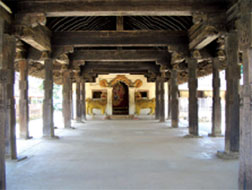 |
|
The Embekke Devala which is believed
to contain carvings of Devendra Mulachari and his son |
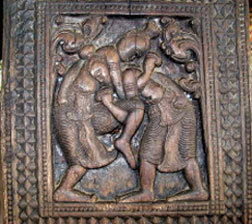 |
|
One of the intricate carvings at
Embekke Devala |
This work took a long time to complete and was still under
construction at the time of King Rajadhi Rajasinha’s death in 1798. It
continued under King Sri Wickreme Rajasinha and was largely completed
during his reign. Many events such as the receiving of foreign
ambassadors, meetings of the highest judiciary and the signing of the
Kandyan Convention in 1815 took place there.
Demise
It was during the construction of the Magul Maduwa or Audience Hall
that events which led to the untimely demise of Devendra Mulachari
occurred. Due to the jealousy of the Kandyan chiefs and courtiers
towards Devendra Mulachari, the former who furnished the timber for the
construction falsely complained to the King that the Mulachari shortened
and rejected the beams brought.
The King thereupon threatened to cut off the fingers of the Mulachari
(apparently the right thumb) who, upon hearing this, to avoid disgrace,
threw himself into the Kandy Lake (Coomaraswamy p. 59, Codrington, p.
240). Subsequently, the King, on learning of the true situation, was in
remorse and is said to have bit his own right thumb and accorded the
Mulachari a funeral with full honours.
Thus ended the life of one of the most brilliant designers and royal
artificers produced by the Kandyan Kingdom and the architect of some of
the historic buildings and constructions in Kandy and the Kandyan
Kingdom.
It is unfortunate that his life and works have not received the
recognition that they deserve. It is time to give due recognition to the
achievements of the brilliant and unique designer and artificer Devendra
Mulachari in producing some of the historic constructions that adorn
Kandy.
The writer is President of the Sri Lanka Institute of Taxation and a
former Commissioner of Inland Revenue. The article is based on his
historical research study in the book 'The Royal Artificers of
Mangalagama and their Descendants' published by Stamford Lake Ltd.
|

